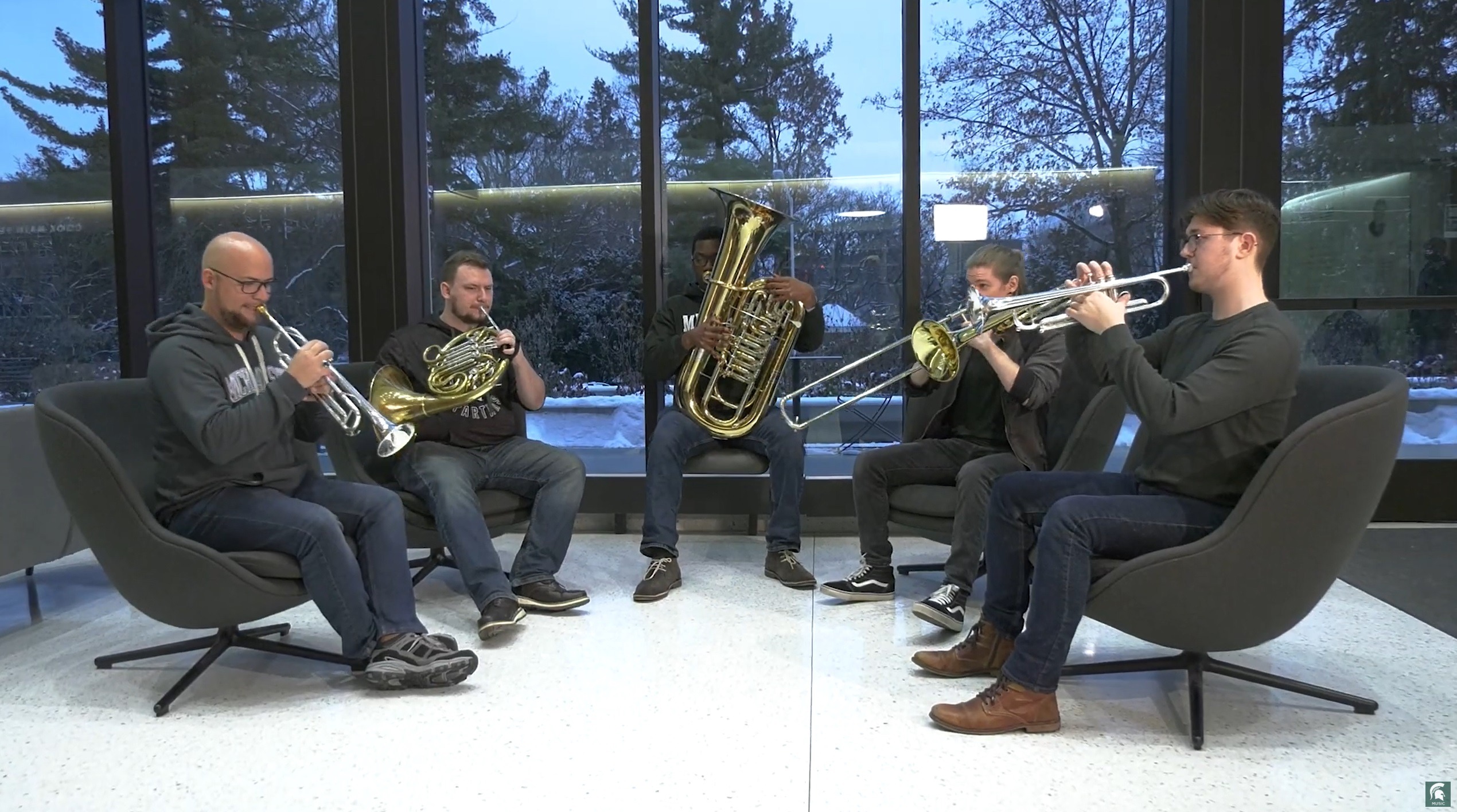Silver Bells
- Home Page 138

Sleigh Ride
Let’s do it again @MSU_Basketball 🟢⚪️🏀 #GoGreen pic.twitter.com/S3l4cKQNcx
— Spartan Brass (@MSUSpartanBrass) March 19, 2022
“Stopping By Woods on a Snowy Evening”
Randall Thompson’s “Frostiana” is a choral cycle based on the poems of Robert Frost. The cycle consists of settings for mixed chorus and piano, and it was premiered in 1959. “Frostiana” was commissioned to celebrate the bicentennial of the town of Amherst, Massachusetts, and it features seven of Frost’s poems set to music by Thompson.
“Stopping by Woods on a Snowy Evening” is one of the poems included in the “Frostiana” cycle. The composition captures the reflective and contemplative mood of Frost’s poem, where the narrator pauses to admire the beauty of a snowy evening in a quiet forest. Randall Thompson’s musical setting adds another layer to Frost’s words, enhancing the emotional impact of the poem.
Thompson’s approach in “Frostiana” is characterized by its accessibility and tonal clarity. His settings aim to convey the meaning and atmosphere of Frost’s poetry through the expressive power of choral music. The entire “Frostiana” cycle is a celebration of both Thompson’s skill as a composer and Frost’s enduring contribution to American literature.
“Stopping by Woods on a Snowy Evening”
By Robert FrostThis is one of my favourite English poems. It is vivid, melancholic, and wistful. The imagery and the final lines have stuck with me for years.
And miles to go before I sleep… pic.twitter.com/2ANM3CeTjQ
— Learn English with Alex (@AlexEngVid) November 25, 2023
Prime Rib Perfection
This content is accessible to paid subscribers. To view it please enter your password below or send mike@standardsmichigan.com a request for subscription details.
Kitchens 300
Commercial kitchens in school cafeterias and college dormitories are designed to meet strict health and safety standards, accommodate high-volume food production, and provide nutritious meals to students in an efficient and organized manner. Some common features:
- Industrial-grade cooking equipment: This may include commercial ovens, grills, ranges, fryers, steamers, and other specialized cooking equipment designed for high-volume cooking.
- Food preparation areas: These may include spacious prep tables, cutting boards, sinks, and other food preparation stations for washing, chopping, and assembling ingredients.
- Walk-in refrigerators and freezers: These are used for storing large quantities of perishable food items at appropriate temperatures to maintain freshness and safety.
- Food storage facilities: These may include shelves, racks, and cabinets for storing dry goods, canned goods, and other non-perishable food items.
- Dishwashing area: This may include commercial dishwashers capable of handling a large number of dishes and utensils efficiently.
- Serving stations: These may include counters, warming stations, and other facilities for serving food to students.
- Ventilation and exhaust systems: These are essential for maintaining a clean and safe kitchen environment by properly removing smoke, steam, and odors generated during cooking.
- Safety features: These may include fire suppression systems, emergency exits, and other safety measures to ensure compliance with local health and safety regulations.
Owing to the complexity of the domain, starting 2023 we will break down the standards for education community safety and sustainability into two separate colloquia:
Kitchens 100 will deal primarily safety — fire, shock hazard, sanitation, floors, etc.
Kitchens 300 will deal with sustainability criteria in large commercial kitchens common in school cafeterias, dormitories, sports venues and hospitals.
Owing to the complexity of the domain, starting 2023 we will break down the standards for education community safety and sustainability into two separate colloquia:
Kitchens 100 will deal primarily safety — fire, shock hazard, sanitation, floors, etc.
Kitchens 300 will deal with sustainability criteria in large commercial kitchens common in school cafeterias, dormitories, sports venues and hospitals.
Relevant catalogs:
3-A Sanitary Standards
AGA Response to The Atlantic Article about Natural Gas Cooking
ASHRAE International
Ventilation for Commercial Cooking Operations
ASTM International
Institute of Electrical and Electronic Engineers
Noteworthy Research:
Design Application of Smart Kitchen for Aging Based on Interactive Behavior Analysis
A Futuristic Kitchen Assistant – Powered by Artificial Intelligence and Robotics
Environmental analyses of waste cooking oil recycling and complete use practices in Bogor, Indonesia
IAPMO International
Prefabricated Gravity Grease Interceptors
International Code Council
International Building Code Sections 303 Commercial Kitchens
National Fire Protection Association
National Electrical Code
Standard for the Installation of Air-Conditioning and Ventilating Systems
The Association for Packaging and Processing Technologies
We will also review federal and state-level regulatory action. Open to everyone. Use the login credentials at the upper right of our home page.
Related:
Eggnog
December is National Eggnog Month
Historians’ best guess as to the origin of eggnog dates back to the English Middle Ages, where a warm, milky ale called ‘posset’, was consumed. Posset was often consumed with eggs and figs; eggs, figs, dairy, and sherry were products that only the wealthy could afford to enjoy at the time. Eggnog was thought to have arrived in the U.S. prior to the revolutionary war. Whereas most of the eggnog consumed in Britain was by the upper class (with sherry), as eggnog advanced throughout the U.S. like a milky river of frothy delight, it was generally consumed with rum or bourbon.
Because the agricultural-based colonies were flush with chickens and cows, the consumption of eggnog was not limited to crusty upper class Brits, but rather a drink that most people throughout the American colonies could enjoy. In fact, food historian, Emelyn Rude (2015), author of “How Eggnog (Almost) Changed the World”, explains that consumption of eggnog was a popular holiday pastime of many, even including West Point cadets, such as Edgar Allen Poe and Jefferson Davis.
Crime Prevention Through Environmental Design
The most widely cited standard on school security in the United States is the Crime Prevention Through Environmental Design guidelines developed by the National Institute of Justice . CPTED is a multidisciplinary approach to deterring criminal behavior through the design and management of the built and natural environment. It emphasizes the importance of designing schools and their surroundings in a way that maximizes natural surveillance, territoriality, and access control, while minimizing opportunities for crime and creating a sense of ownership and community.
CPTED guidelines have been adopted by many schools and law enforcement agencies across the country and are often referenced in school safety plans, security assessments, and training programs required by the Clery Disclosure of Campus Security Policy and Campus Crime Statistics Act.
Bethlehem Down
The secular world adapts;
the Church endures.
History of Western Civilization Told Through the Acoustics of its Worship Spaces
New update alert! The 2022 update to the Trademark Assignment Dataset is now available online. Find 1.29 million trademark assignments, involving 2.28 million unique trademark properties issued by the USPTO between March 1952 and January 2023: https://t.co/njrDAbSpwB pic.twitter.com/GkAXrHoQ9T
— USPTO (@uspto) July 13, 2023
Standards Michigan Group, LLC
2723 South State Street | Suite 150
Ann Arbor, MI 48104 USA
888-746-3670




















